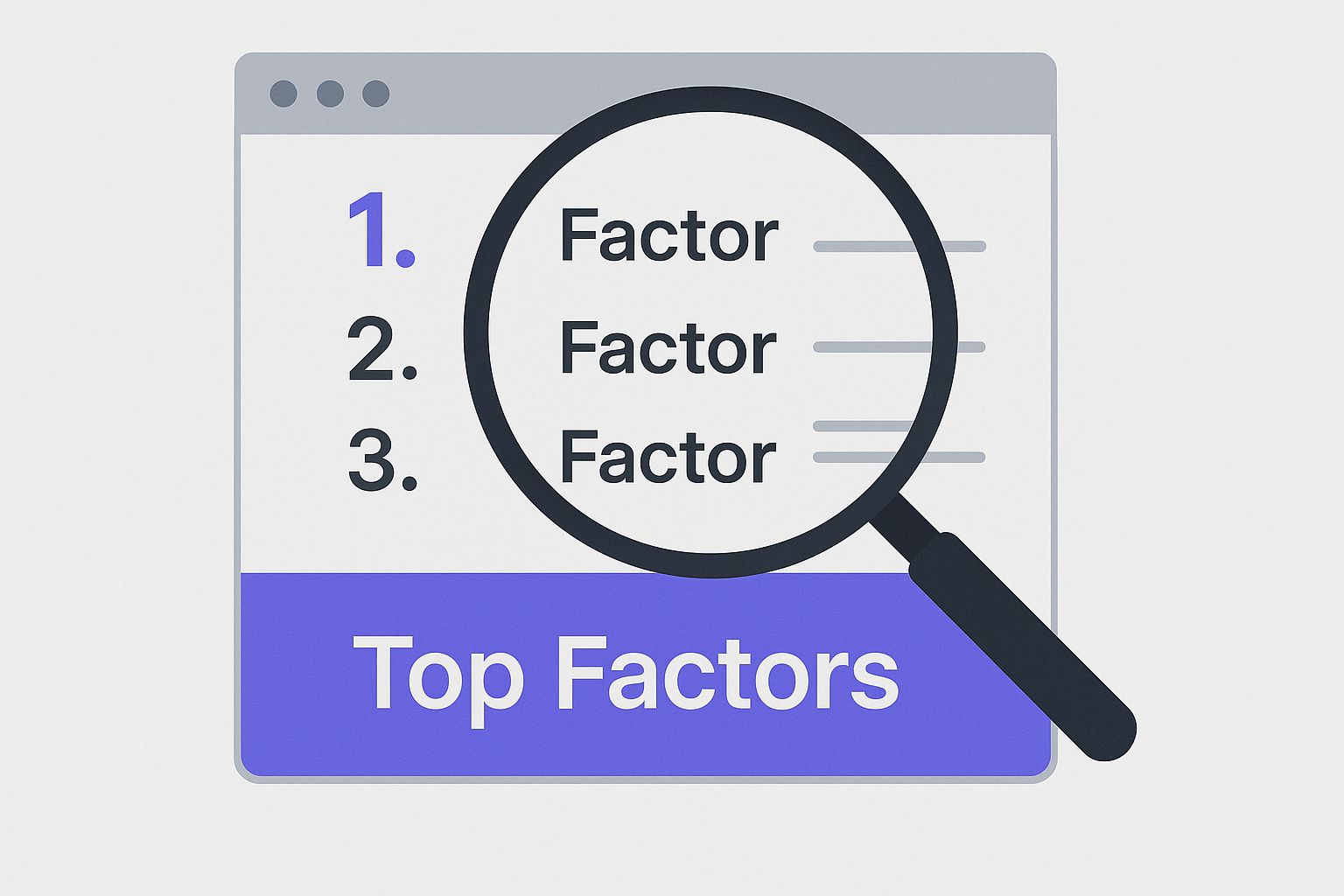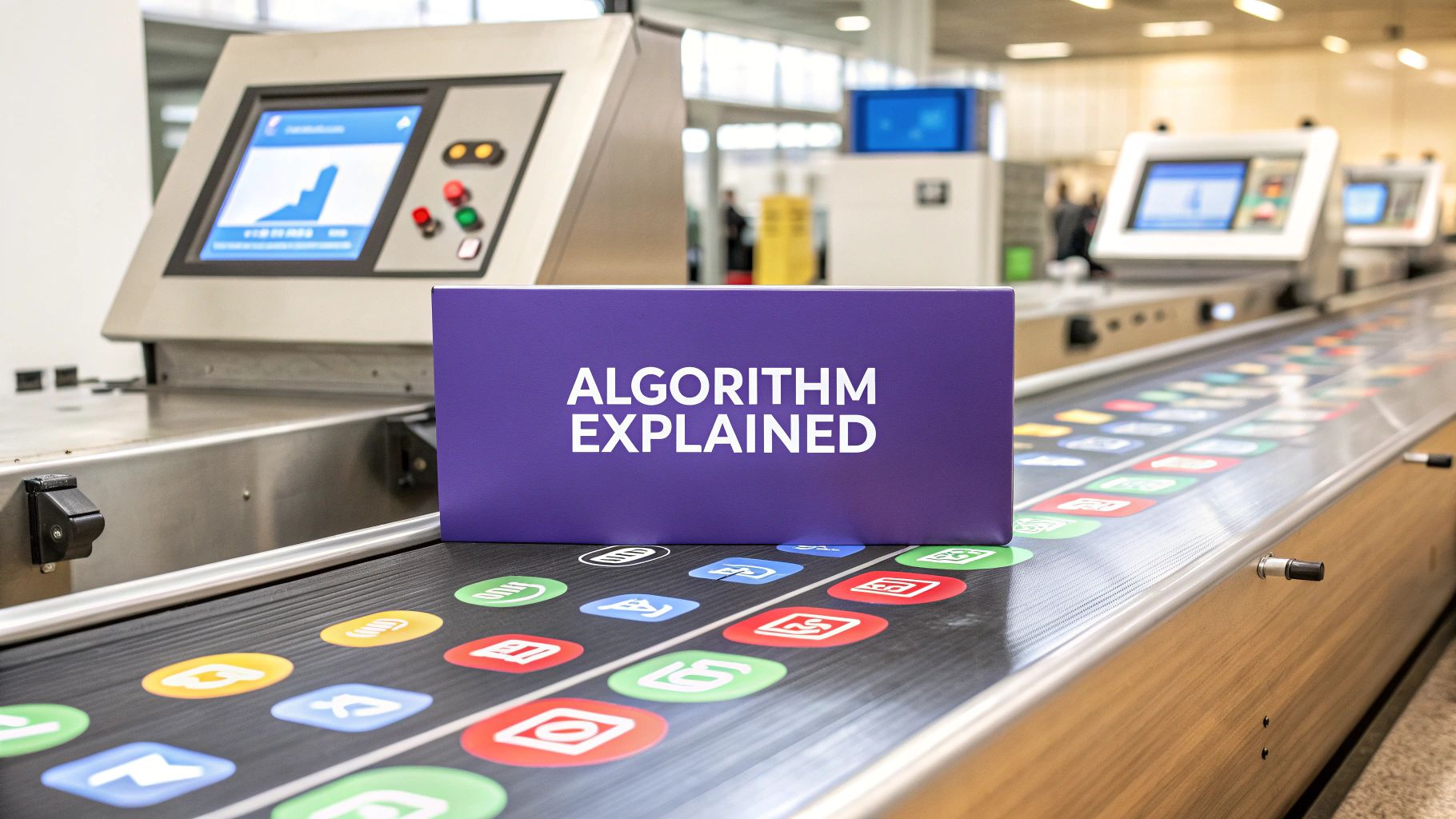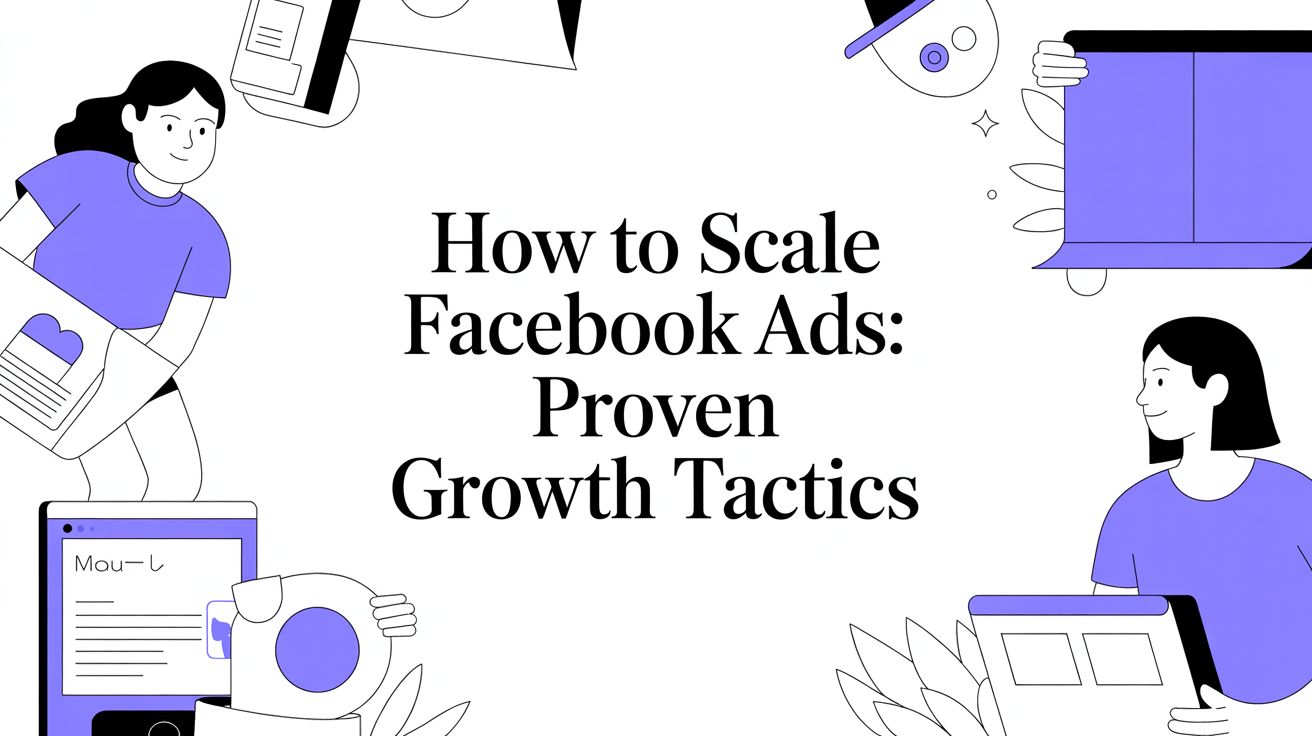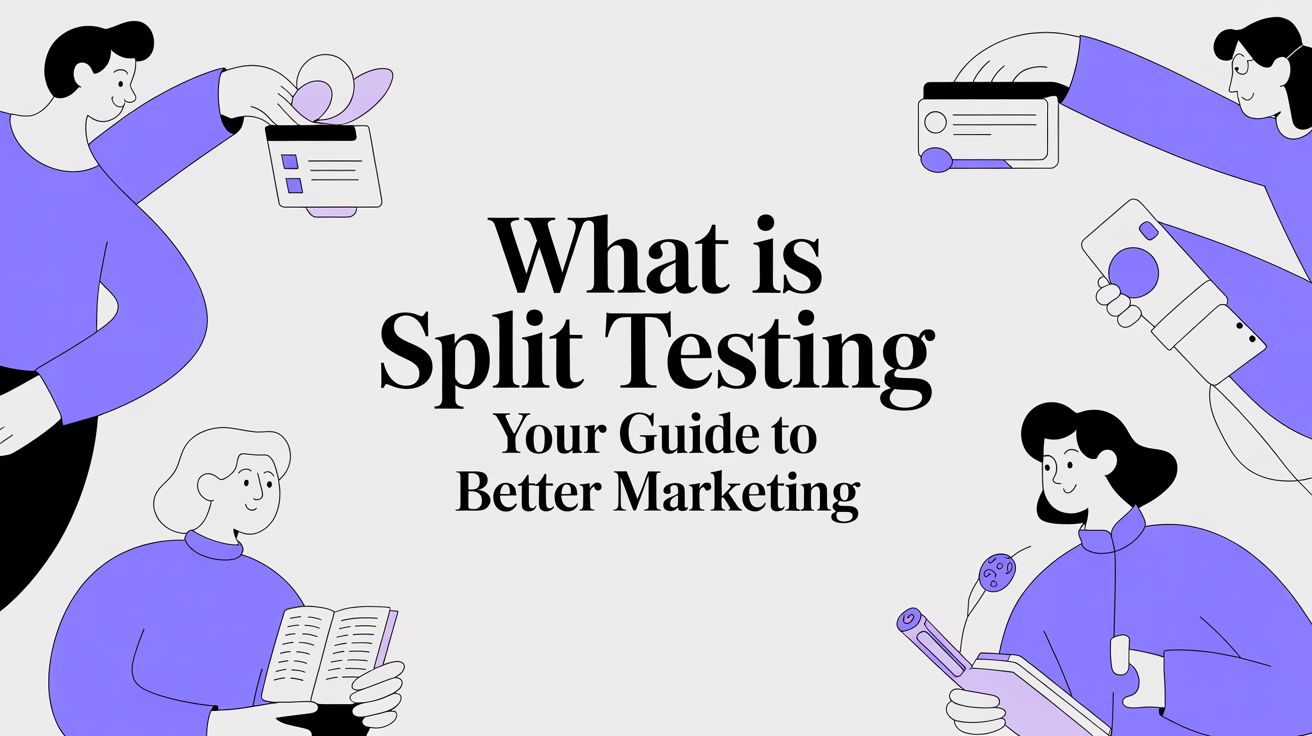So, what exactly is a social media algorithm? At its heart, it’s a sophisticated system of rules that sorts content, deciding what you see and in what order. It's less like a chronological list and more like a personal DJ, sifting through millions of posts to spin a unique playlist of content it thinks you'll love.
What Is a Social Media Algorithm?
Imagine trying to drink from a firehose. That's what social media would feel like without algorithms. If platforms simply showed you every post from every account you follow, the second it was published, your feed would be a chaotic, overwhelming mess. You'd probably miss that engagement announcement from your best friend because it was buried under a hundred brand promotions you don't care about.
That's the problem algorithms were built to solve. They act as a filter, paying close attention to your every move—what you like, who you comment on, how long you watch a video, and even what you scroll past quickly. All this data helps the platform build a profile of your interests.
This system then curates a feed tailored just for you, prioritizing posts it predicts will keep you hooked. In essence, algorithms are the gatekeepers that determine which pieces of content get prime real estate in front of billions of eyeballs.
The Purpose of a Social Media Algorithm
The end goal for any platform is simple: keep users happy and on the app for as long as possible. The algorithm is their primary tool for making that happen. It works to:
- Improve the User Experience: By cutting through the clutter, algorithms deliver a feed that feels relevant and interesting, not stressful.
- Boost Engagement: When you see things you genuinely like, you’re far more likely to interact. More likes, shares, and comments signal success to the platform and keep you coming back.
- Drive Content Discovery: It’s not just about showing you more from accounts you already follow. Algorithms are also designed to introduce you to new creators and topics they think you'll find interesting, helping you discover fresh content and communities.
These systems are more than just code; they're powerful gatekeepers that shape how we communicate and consume information online. They've come a long way from the simple, chronological feeds of the past, now playing a massive role in what gets seen and what gets ignored.
For anyone trying to build a brand or a following, this is a game-changer. Over the past ten years, algorithm updates have caused organic reach to plummet for business pages, with some studies showing drops as sharp as 60-70%. This means you can no longer just post and pray. To succeed, you have to understand what makes these systems tick. You can learn more about the evolution of social media algorithms to see just how much has changed.
The End of the Chronological Feed

Remember the good old days? A time, not so long ago, when your social media feed was simple. The newest post sat right at the top, and the oldest was at the bottom. This chronological feed was clean and easy to understand. But as social media exploded, this simplicity created a huge problem.
It was like trying to drink from a firehose.
With millions of people and brands posting every second, keeping up became impossible. That important update from your best friend? It was instantly buried under a tidal wave of brand promotions, posts from that person you met once, and random group updates.
The experience was becoming a chaotic mess. Platforms knew that to keep people scrolling, they had to stop showing them everything and start showing them the best things. This was a game-changing shift.
The Rise of Relevance
The answer was to move from a system based on recency to one built on relevance. Instead of asking, "What was just posted?" the platforms started asking, "What will you actually find interesting?" This is where the modern social media algorithm found its purpose. It became a personal curator, not just a conveyor belt for content.
Facebook was one of the first to really run with this idea. In 2011, they introduced 'EdgeRank,' an early algorithm that ranked posts using three core factors: your relationship with the creator, the type of content, and how old the post was. This marked the beginning of the end for the purely chronological timeline. You can read more about this historic shift in social media curation to see how it all started.
This wasn't just a small adjustment; it was a complete reinvention of how we experience social media.
The death of the chronological feed was the birth of the personalized web. It was the moment platforms decided their job wasn't just to host content, but to organize it in a way that kept you on their site for as long as possible.
Why This Shift Still Matters
Knowing this history is so important because that core principle—solving the "firehose" problem—is still what drives every algorithm today. The goal is always to surface the content that is most relevant to you.
It’s the reason you see a post from your sister from three days ago ranked higher than a brand post from three minutes ago. The algorithm has calculated that you care more about what your sister is up to. This constant battle for relevance is what determines which content gets seen and which gets lost in the noise. Grasping this is the first step for anyone trying to build an audience, which is a key part of any good multi-platform content delivery strategy.
This move away from chronological feeds set the stage for the complex, personalized systems we all use today, where relevance and relationships are the name of the game.
The Core Ingredients of Every Algorithm
While every social media platform has its own secret sauce, their algorithms all start with a few of the same core ingredients. It's a lot like cooking—whether you're making a stew or a sauce, you almost always start with a base of onions, carrots, and celery. Social media algorithms are built on a similar universal foundation.
Before we dive into the specifics of TikTok or Instagram, understanding these core principles gives you a powerful way to think. Once you get this framework, you can look at any platform and have a pretty good idea of what makes it tick.
At the heart of it all, you'll find three main ranking signals that work together to build the feed you see every day.
Relationship: Who You Know and Interact With
The first, and arguably most powerful, ingredient is Relationship. Algorithms are constantly watching your digital body language. They see who you interact with the most and assume those are the connections that matter most to you.
This signal is all about your history on the platform. A post from your best friend, who you message every day, will almost always show up before a post from an acquaintance you haven't engaged with in years.
The algorithm is looking for actions like:
- Direct messages and frequent chats.
- Liking, commenting on, or sharing someone's content.
- Tagging each other in photos or posts.
- Checking someone's profile or stories on a regular basis.
Basically, the more you engage with an account, the louder you're telling the algorithm, "Hey, this person matters to me!" The system then prioritizes their content to make sure you don’t miss what's happening with the people you care about.
Interest: What You Actually Engage With
Next up is Interest. This is where the algorithm becomes a student of your personal tastes. It carefully tracks the topics, themes, and formats that grab and hold your attention. Every single action you take is a vote for what you want to see more of.
If you find yourself constantly liking and commenting on posts about vintage cars, the algorithm quickly learns you're an auto enthusiast. Before you know it, it's showing you more content from car restoration accounts, local car shows, and other people who share that same passion.
You are constantly teaching the algorithm what you like. The more you "vote" with your time and engagement—watching a full video, saving a recipe, or sharing a funny meme—the more accurately it can predict what will keep you scrolling.
This signal analyzes everything from the words in a caption to the objects identified in a video. It's the reason your "For You" page can sometimes feel like it's reading your mind. This is also what makes influencer marketing so powerful; by working with creators who already have an engaged audience in a specific niche, brands can connect with people pre-qualified by the algorithm itself. To learn more, see how this works in our guide to AI influencer marketing strategies.
Recency: How New the Content Is
The final core ingredient is Recency. Social media has moved way beyond the old-school chronological feed, but timing still counts for a lot. People want to see what’s happening now, not what happened last week. Because of this, algorithms are always trying to strike a balance between relevance and freshness.
This is why your feed is usually a mix of brand-new posts and slightly older content that's getting a ton of engagement. The system gives new posts a window to gain some traction. If a post gets a flurry of interaction right after it's published, the algorithm takes that as a sign of quality and pushes it out to more people.
On the other hand, if a post is a few days old and hasn't made a splash, it'll get pushed down the feed to make room for newer stuff. The algorithmic jackpot is hitting all three: a recent post, about a topic you love, from an account you interact with all the time.
To really nail this down, it helps to see these signals laid out side-by-side.
Key Algorithmic Ranking Signals Explained
This table breaks down the primary signals that most social media algorithms use to rank and display content, helping you understand what drives visibility.
| Signal Category | What It Means | Example User Actions |
|---|---|---|
| Relationship | The algorithm prioritizes content from accounts you have a strong connection with. | Liking their posts, sending DMs, being tagged together, searching for their profile. |
| Interest | The algorithm learns your tastes based on the content and topics you engage with. | Watching a video to the end, sharing a post, saving a post, commenting on specific topics. |
| Recency | Newer content is generally favored to keep the feed fresh and timely. | Prioritizing posts published in the last few hours or days over older content. |
As you can see, these signals are the foundation. By understanding how Relationship, Interest, and Recency work together, you're in a much better position to create content that both platforms and their users will value.
This infographic gives you a visual breakdown of how these factors come together to sort and rank the content you see.

Master these three ingredients, and you're already well on your way to cracking the code.
How Different Social Media Algorithms Work

While most platforms use the same core ingredients—relationship, interest, and recency—each one has its own secret recipe. Think of it this way: every chef starts with flour, water, and salt, but one bakes a sourdough loaf while another creates a thin-crust pizza. Each social network tunes its algorithm for a very specific purpose.
Getting a feel for these platform "personalities" is the key to creating content that actually performs. What crushes it on TikTok might fall completely flat on LinkedIn, and a viral Instagram Reel doesn't automatically mean you'll have a hit on Facebook.
This shift from simple chronological feeds to these complex, curated experiences didn't happen overnight. It really started around 2009, when platforms like Facebook began using algorithms to deal with the sheer explosion of content. By 2016, most of the major players, including Instagram, had made the switch. Then, the meteoric rise of TikTok from 2018 onward cemented the algorithm's power, with its "For You Page" setting a new gold standard for personalization. If you want to go deeper, you can explore the history of social media algorithms and see how we got here.
So, let's break down how the giants of social media tweak their systems.
The Instagram Algorithm: A Multi-Faceted System
First off, Instagram doesn't have one algorithm; it has several. Each part of the app—the Feed, Stories, Reels, and the Explore page—uses its own distinct set of rules, all tailored to how you use that specific feature.
- The Feed and Stories: This is where the Relationship signal is king. The algorithm shows you content from the accounts you interact with the most, whether that's friends, family, or your favorite creators. It's watching your likes, comments, DMs, and saves to figure out who you genuinely care about.
- The Explore Page: This is all about discovery. Its main job is to introduce you to new things. If you've been liking a ton of posts about landscape photography, your Explore page will soon be filled with stunning shots from photographers you've never heard of.
- Reels: The Reels algorithm is built for pure entertainment and massive reach. It absolutely loves content that is engaging, looks great, and uses trending audio. Unlike the Feed, it's designed to show you content from almost anyone, not just people you follow. Watch time is everything here; if your Reel keeps someone watching until the very end, Instagram will push it out to a much bigger audience.
The TikTok Algorithm: The Ultimate Discovery Engine
The TikTok algorithm is famous for how freakishly fast it learns what you like. Its power comes from the "For You Page" (FYP), that endless, personalized stream of content.
Unlike other platforms that care a lot about who you already follow, TikTok is all about content discovery. It genuinely doesn't matter if an account has 10 followers or 10 million. If the video is good, it has a shot at going viral.
TikTok's algorithm operates on a simple premise: your attention is the most valuable currency. Every second you spend watching a video, every re-watch, and every share is a powerful signal that tells the system, "Show me more of this."
The main ranking factors are pretty straightforward:
- Video Completion Rate: Did the viewer watch the whole thing? This is probably the single most important metric.
- User Interactions: This includes the classic stuff—likes, comments, shares, and even follows that come directly from the video.
- Video Information: Hashtags, sounds, and captions are crucial. They help the algorithm figure out what your content is about so it can show it to the right people.
The Facebook Algorithm: Connecting People and Communities
The mission for Facebook has always been about connecting people. Its algorithm is built to prioritize what it calls "meaningful interactions" between friends, family, and community groups. This means it values a thoughtful comment or a share way more than a simple "like."
It ranks content based on who posted it, what kind of content it is (video, photo, or link), and how much engagement it’s getting. If a post sparks a ton of conversation among a small group of people, Facebook sees that as high-quality and will start showing it to more users.
For brands, this means creating content that sparks conversation is the only way to get seen. Asking questions, running polls, and posting about relatable topics are all winning strategies.
The LinkedIn Algorithm: Professional Relevance and Credibility
The LinkedIn algorithm has a completely different job to do. It’s all about professional networking and sharing knowledge. Its goal is to show you content that’s genuinely relevant to your industry, career, and professional life.
It filters content pretty heavily, trying to promote high-quality, credible posts while burying anything that looks like spam. The algorithm absolutely favors content that generates thoughtful comments and real discussion.
Here are the key signals for the LinkedIn algorithm:
- Your Connections: It prioritizes posts from people you know and actually engage with.
- Early Engagement: A post that gets a good amount of likes and comments soon after you hit "post" is far more likely to be shown to a wider audience.
- Content Quality: Well-written articles, insightful commentary, and professional videos will always outperform a simple link or a salesy post.
Understanding these platform-specific quirks is the final piece of the puzzle. Once you tailor your approach to what each algorithm values, you can stop fighting against the current and start using it to your advantage.
How to Work with Social Media Algorithms
Knowing the theory behind social media algorithms is one thing, but actually using that knowledge to get results is a whole different ball game. The secret isn't trying to "beat" or "trick" the system. The smartest creators and brands figure out how to work with the algorithms, creating stuff that platforms and people genuinely want to see.
Think of it less like a fight and more like a dance. When you give the algorithm high-quality content that gets people to react, it rewards you by showing it to more users. It’s a win-win-win: the platform keeps users scrolling, users find content they love, and you get to grow your audience. Here’s how to make that happen.
Create Content That Sparks Conversation
At the end of the day, social media algorithms want to promote content that keeps people logged in and interacting. And what does that better than a great conversation? Posts that get a real back-and-forth going in the comments send a huge signal to the algorithm that you’ve posted something worthwhile.
So, stop just making announcements. Start asking questions. Run a poll. Share a hot take that gets people talking (in a good way!). When people take the time to comment, the algorithm notices that high-level engagement and pushes your post out to a much wider audience.
An engaged community is your single greatest asset. Every comment, share, and save is a vote of confidence that tells the algorithm your content is worth amplifying.
This is about more than just numbers. When you build a community that actually talks back, you create a loyal base that algorithms simply can't overlook. This gets even more powerful when you start featuring your audience's own content. Learning about the incredible benefits of user-generated content can give your engagement signals a massive, authentic boost.
Master the Right Formats for Each Platform
An algorithm doesn't see all content as equal. Every platform has its favorite formats, and if you play to those strengths, you'll get a shortcut to better reach. Right now, short-form video is king just about everywhere.
- For Instagram and Facebook: Put your energy into Reels. They are built for discovery and can take your content far beyond your current follower list.
- For TikTok: The entire platform is built on short, snappy videos. Jumping on trends and using popular sounds is non-negotiable if you want to land on the For You Page.
- For LinkedIn: Video works here too, but don't sleep on high-quality carousels and insightful text posts. These can spark serious professional discussions and expand your network.
Simply adapting your ideas to fit the native format shows the algorithm you get it. It’s a small change that can make a huge difference in who sees your posts.
Build Momentum with a Consistent Schedule
Consistency is a big deal for every social media algorithm. When you post regularly, you’re telling the platform you're an active, reliable creator, and that can earn you some serious points in the feed. This isn't about spamming your followers ten times a day; it's about finding a rhythm you can actually stick to.
A predictable schedule also trains your audience to look for your content and engage with it right away. That first wave of interaction is critical because algorithms use early engagement to predict how well a post will perform over time.
To really get the most out of every post, you need to publish it when your audience is actually online and scrolling. Finding the best times to post on social media is a simple but powerful way to feed the algorithm that "recency" signal we talked about earlier.
Still Have Questions About Social Media Algorithms?
Once you start to get the hang of how algorithms work, the specific questions really start to pile up. It’s easy to get lost in myths and old advice because these systems often feel like a black box. Let’s clear the air and tackle some of the most common questions I hear all the time.
Think of this as a quick-and-dirty FAQ to help you navigate the day-to-day quirks of social media algorithms. We'll cover everything from retraining your feed to the real role of hashtags and the frustrating mystery of fluctuating reach.
Can I Actually Reset a Social Media Algorithm?
You can't just hit a big red "reset" button, but you can absolutely retrain an algorithm to show you what you want to see. The whole secret is to be intentional and consistent with your actions on the platform. Your behavior is the loudest signal you can send.
Start by deliberately engaging with content you do want more of. That means liking, commenting, and sharing posts that genuinely interest you. On the flip side, be aggressive about using features like "Not Interested" or muting accounts and topics you don't find valuable.
It takes a little time, but these strong signals will teach the algorithm your new preferences. Another great move is to periodically clean up your "following" list. Unfollowing inactive or irrelevant accounts is like tidying up its understanding of what matters to you.
Do Hashtags Still Matter to the Algorithm?
Yes, they absolutely do, but maybe not in the way you think. Their main job has changed. It's better to see them as categorization labels rather than magic wands for discovery. Using relevant hashtags is you telling the algorithm, "Hey, this is what my post is about."
This simple act helps the system do its job better by matching your content with people who are already into that topic. In fact, a 2023 study showed that posts with even one hashtag get way more engagement than posts with none.
The real trick is to use a smart mix of broad, niche, and community-specific tags. Just spamming the most popular hashtags is a waste of time compared to using targeted tags that actually describe your content.
Why Is My Reach and Engagement All Over the Place?
First off, it's totally normal. Your content's reach will always have its ups and downs, and there are a few key reasons for this. For one, platforms are constantly tweaking their algorithms behind the scenes. These little adjustments can cause temporary shifts in visibility as the system settles.
Second, you're always competing for attention. If a massive news story breaks or a viral trend explodes, there's just less real estate in people's feeds. Your post's performance is always relative to everything else happening on the platform at that exact moment.
And finally, algorithms often test your content with a small group first. If that initial audience loves it and engages heavily, its reach gets a huge boost. If it falls flat, the algorithm cuts its losses and limits distribution. This is exactly why focusing on consistent quality is so much more important than obsessing over any single post.
Does the Algorithm Really Favor Video Content?
Right now, the evidence is pretty undeniable: most major platforms are giving a massive leg up to short-form video content. We're talking TikToks, Instagram Reels, and YouTube Shorts. This isn't an accident—it's a direct response to how users behave and what the platforms want.
Video is incredibly sticky. It keeps people on an app longer, which is the number one goal for any social media company. The algorithm is just built to push the formats that help it achieve that goal most effectively.
Of course, high-quality photos and great writing still have their place, especially on networks like LinkedIn or Pinterest. But if you want to maximize your reach today, building a video strategy is one of the surest bets for working with the algorithm, not against it.
Ready to create high-performing videos that algorithms love, without the hassle? Sprello uses AI to turn your existing assets into engaging, UGC-style video ads in minutes. Scale your content, test new ideas, and drive results. Start your free trial at sprello.ai.



